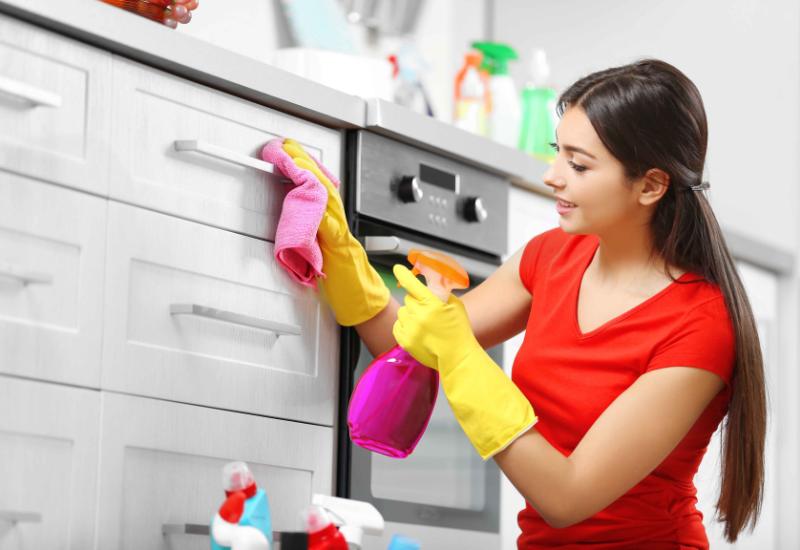Ultimate Guide to Cleaning Kitchen Cabinets: Tips and Techniques
Vihaan Disouza
. 3 min read
We all want our kitchen cabinets to look clean and sparkling, but cleaning them can be a pain. It's good that you're here because we've got an easy guide to help you clean kitchen cabinets and get them back in shape. You'll learn about what kind of products and tools you need, different ways how to clean kitchen cabinets, how to make sure they stay clean for as long as possible. With the advent of technology, platforms like omegle chat provide a space where you can connect with other homeowners and exchange cleaning hacks, recommendations, and experiences, further enhancing your knowledge and ensuring your kitchen cabinets remain spotless.

Here's Everything you need to know about Cleaning Kitchen Cabinets
1. Choose a Cleanser
Dishwashing liquids or mild laundry detergents are effective cleaners for most cabinet materials. To make sure your cleanser isn't too strong, you may want to dilute one part detergent in two parts warm water to make an easy kitchen cleanser. When using laundry detergent, it's a good idea to use one that is specially designed to remove grease and oil.
1.1 - Vinegar:- Vinegar is a good, natural, all-purpose cleaner that can clean kitchen cabinets and remove buildup. Try using a solution of half vinegar and half water for cabinets that just need a regular cleaning; to cut through greasy buildup, apply undiluted vinegar. Lemon juice can be used instead of vinegar if you don't like the smell.
- Clean cabinets with soap and water.
- Dunk your sponge or microfiber cloth in the suds and squeeze out excess water.
- Start at the top and wipe down cabinet doors inside and out.
- Rinse the dirt from your cloth or sponge frequently with clean water.
- Change the rinse water periodically if you’re using a separate bucket.
- Re-load the sponge with fresh soapy water and continue.
- Scrub the areas near the handles or knobs to remove fingerprints and greasy residue.
2. Cleaning Painted Cabinets in Your Kitchen
An oil-based cabinet surface is a lot more durable than a wood cabinet door. Oil-based surfaces can stand up to a lot of scrubbing without ruining the finish. Use any of the homemade recipes we provide or purchase an all-purpose cleaner. As the surface isn’t susceptible to scratching, you can scrub the surface as hard as necessary to remove stuck on food or stubborn stains. Cleaning kitchen cabinets with baking soda should only be done on oil-based painted surfaces.
1. In a medium-sized bowl, mix Borax, vinegar, and dish soap with a spoon or whisk. Dip your material into the cabinet cleaner and wipe down all of your painted surfaces. Pay close attention to areas around knobs, corners, and edges.
2. Rinse and remove all remaining suds with a clean, damp cloth. Use a Magic Eraser on any stubborn stains left behind. After cleaning your painted surfaces, apply a thin layer of clear paste wax.
3. The wax protects the surfaces from everyday stains and splatter. Avoid using liquid wax or orange oil on your painted surfaces as these react negatively with the paint.
4. Diluted ammonia is an excellent way to remove grease from painted kitchen cabinets. If using diluted ammonia or an ammonia-based cleaner, ensure you have proper ventilation, use exhaust fans, and open windows.
Overall, the paint will chip and wear off your kitchen cabinets, no matter how well you take care of them. When chipping or peeling occurs, you will need to take care of removing old paint from kitchen cabinets and either repaint or replace your cabinets.
How to Clean Laminate Doors of Kitchen Cabinets?
The following tips are going to be helpful for those who keep their kitchen doors clean and tidy:
- Always begin cleaning the laminate doors by first dusting off the surface.
- Refrain from using hard scrubbers or potent chemical cleaners to clean the kitchen cabinets as they can damage the upper layer.
- Use a warm soapy solution with a soft bristle plastic bristle to clean the oily scum that accumulates over the surface.
- Avoid pouring a cleaning solution directly over the kitchen cabinet. This can lead to stains all over the surface. Always use a damp sponge or use a spray bottle to pour the cleansing liquid on the laminate door for effective results.
Hydrogen Peroxide
The easiest and simplest way to clean the kitchen drawer containing utensils is to use hydrogen peroxide. This will help get your cabinet shinier, and you will not have to work too hard for this.
- First, prepare a solution by putting one to two spoons of hydrogen peroxide and two to three mugs of water in a vessel.
- After preparing, spray it well on the drawer and rub it with a cleaning brush.
Conclusion
In conclusion, cleaning kitchen cabinets can be a daunting task, but it is essential to maintain the cleanliness and hygiene of your kitchen. Dishwashing liquids, mild laundry detergents, vinegar, and baking soda are effective cleansers for most cabinet materials. Additionally, applying a thin layer of clear paste wax or diluted ammonia can protect the surfaces and remove stubborn stains. Regular dusting and avoiding harsh scrubbers or chemical cleaners can also help keep your kitchen cabinets clean and sparkling. By following these tips and tricks, you can keep your kitchen cabinets looking good and maintain a healthy environment in your kitchen.
More Stories from
Budget-Friendly Tips to Keep Your House Safe While You're Abroad
Protect Your Home: Inexpensive Ways to Keep Your House Safe While You're Abroad.
Home Security Tips: How to Protect Your Home from Burglars?
It provides tips for preventing burglaries and home invasions, including ways to identify and deter potential thieves, and ways to keep your home.
Home Security Tips: Protecting Your Home from Burglars
The article provides tips for home security and preventing burglaries.
Decluttering Your Home: Items You Need to Get Rid of Now
This article provides a list of items that people should consider throwing away or recycling in order to declutter their homes and live a healthier lifestyle.
Home Security Tips: Protect Your Home from Burglary and Intrusions
This article provides practical tips and creative ideas to enhance home security and protect against burglaries.




.jpg?width=250&aspect_ratio=16:9)
.jpg?width=250&aspect_ratio=16:9)
.png?width=40&aspect_ratio=1:1)



.png?width=40&aspect_ratio=1:1)

